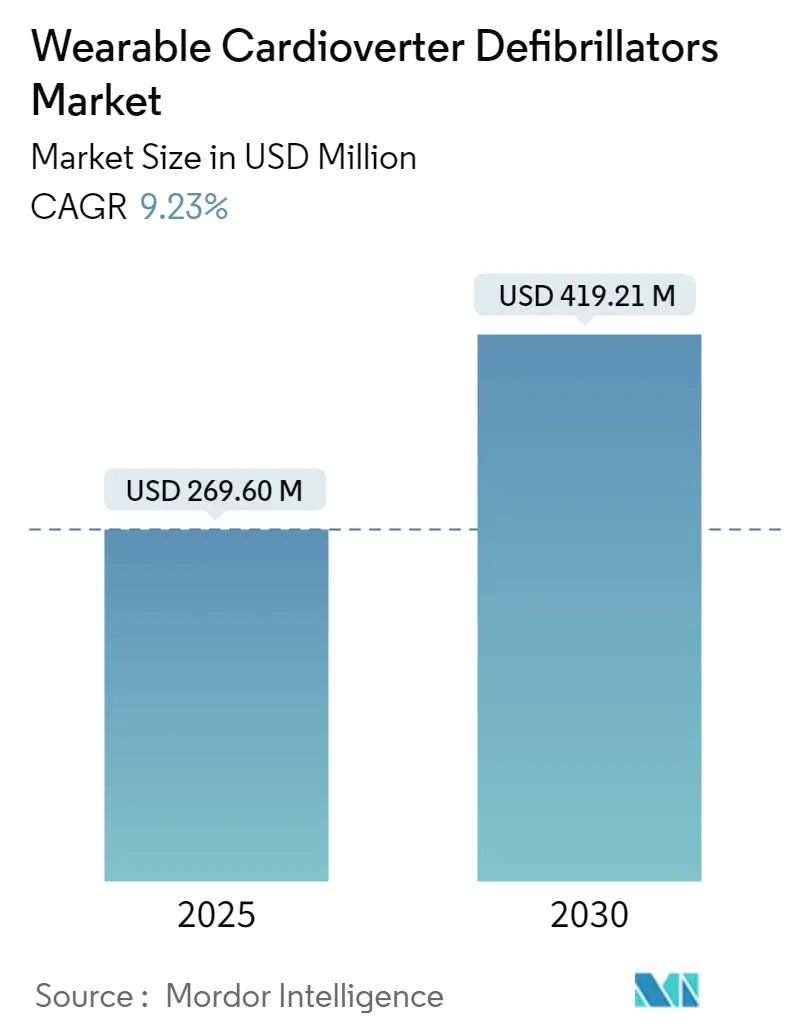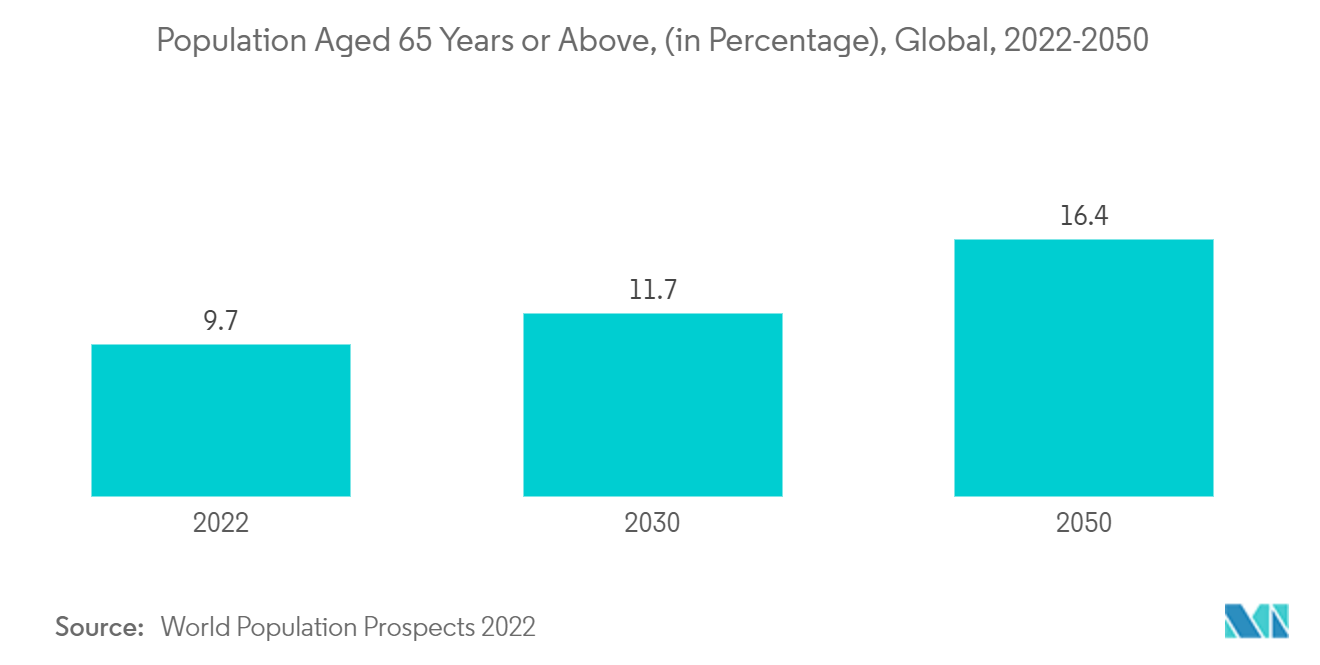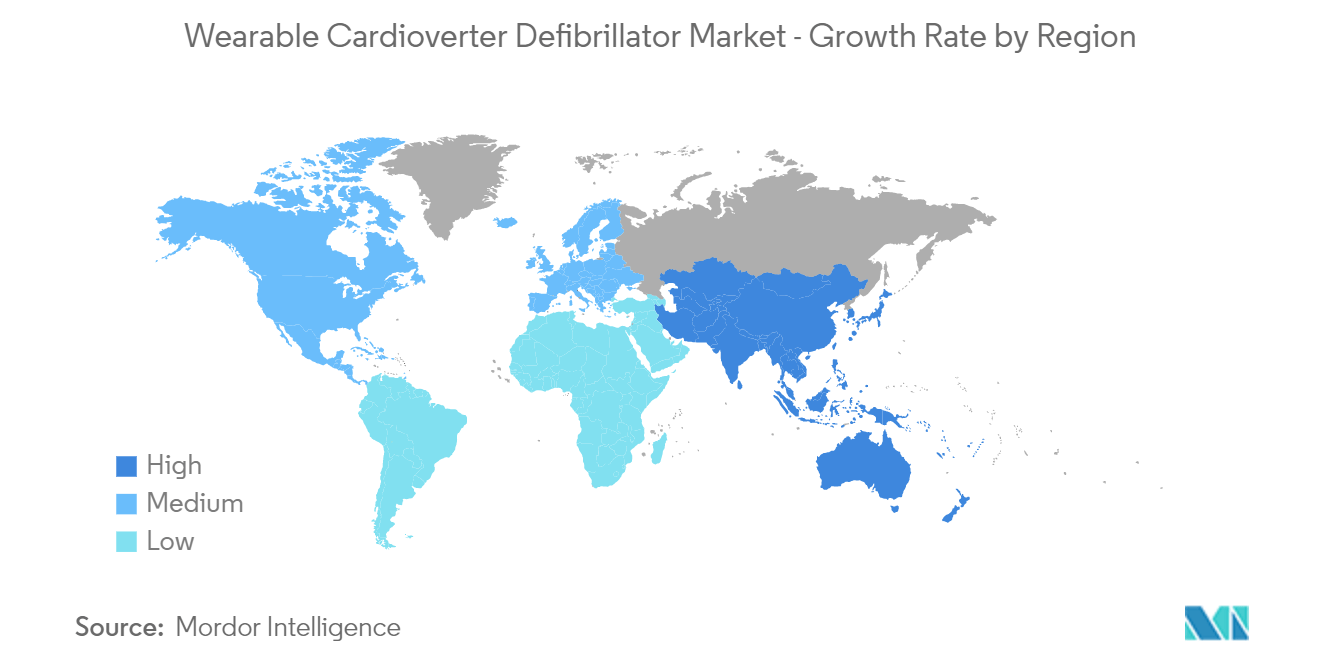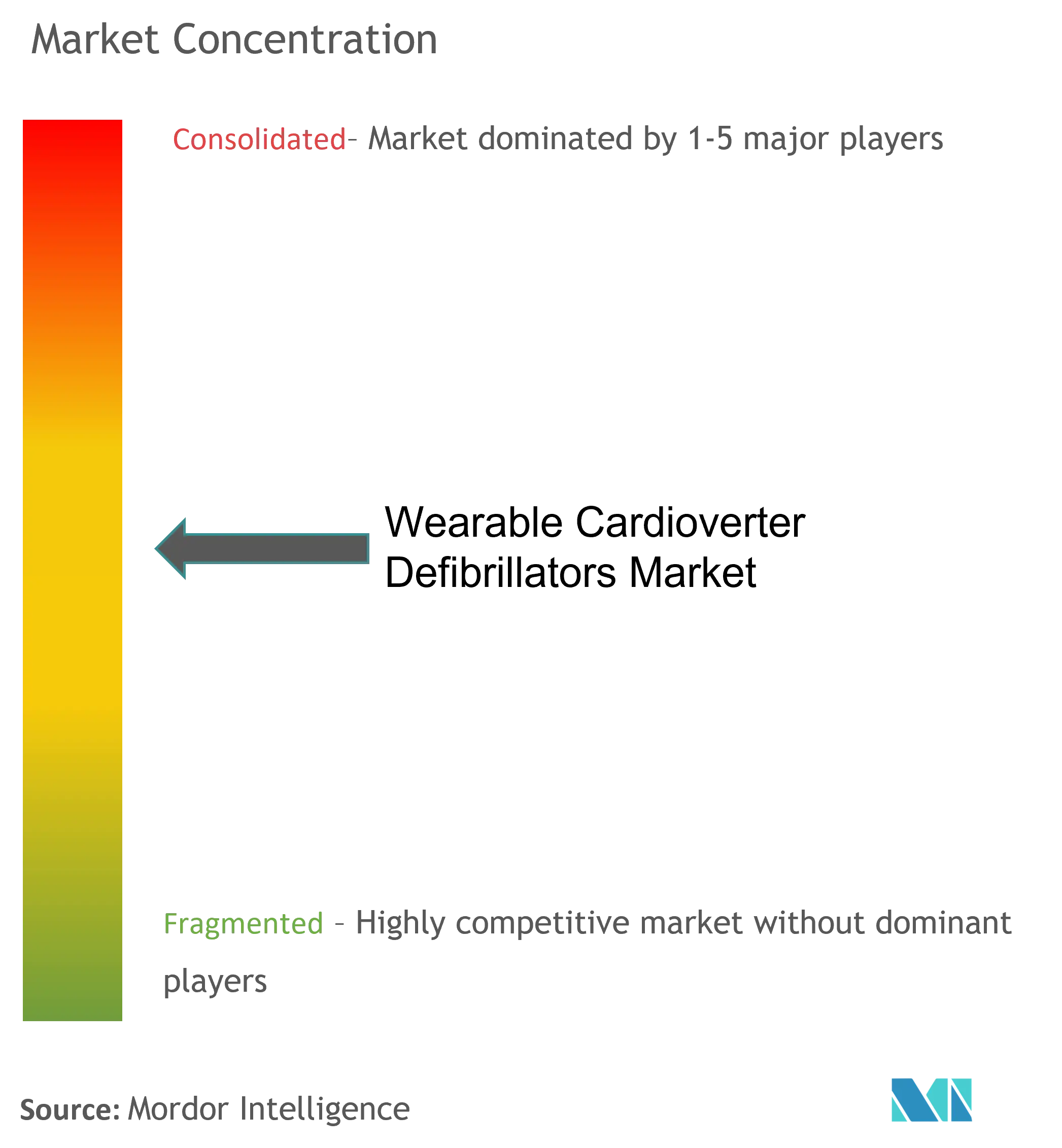Wearable Cardioverter Defibrillators Market Size and Share

Wearable Cardioverter Defibrillators Market Analysis by Mordor Intelligence
The Wearable Cardioverter Defibrillators Market size is estimated at USD 269.60 million in 2025, and is expected to reach USD 419.21 million by 2030, at a CAGR of 9.23% during the forecast period (2025-2030).
The COVID-19 pandemic significantly impacted the growth of the wearable cardioverter defibrillator market. An article published in Nature Medicine in February 2022 observed that people with COVID-19 are more likely to have cardiovascular diseases, such as heart failure, thromboembolic disorders, dysrhythmias, ischemic and non-ischemic heart disease, pericarditis, myocarditis, and ischemic and non-ischemic heart disease. Thus, the high burden of CVD-related diseases raised the demand for wearable cardioverter defibrillator devices to monitor heart rhythm during the pandemic period as they allowed contactless communication and tracking of medical conditions by clinicians. Moreover, with released restrictions and resumed cardiac treatment and services, the studied market is expected to grow over the forecast period.
Factors such as the increasing prevalence of cardiovascular disorders, the rising geriatric population, and the ease of use of non-invasive devices are boosting the market growth. For instance, as per BHF's 2022 report, more than 7.6 million people in the United Kingdom were living with cardiovascular diseases in 2021. Hence, cardiovascular diseases and their high prevalence is expected to increase the demand for regular monitoring of heart rhythm, propelling the market growth. Also, according to the October 2022 update of the CDC, about 805,000 people in the United States have a heart attack every year. Hence, cardiovascular diseases and their high prevalence is expected to increase the demand for regular monitoring of heart rhythm, propelling the market growth.
In addition, the increasing prevalence of obesity, diabetes, hypertension, and high cholesterol among the population is contributing to market growth. According to the 2022 statistics published by UNICEF World Obesity Atlas, more than 27 million children will suffer from obesity by 2030 in India. Thus, the expected increase in the obese population may increase the risk of atrial fibrillation (AF), which reduces blood flow and leads to a heart attack. This is anticipated to propel the demand for cardioverter defibrillator devices, bolstering the market growth.
Also, according to the 2022 statistics published by IDF, about 537 million adults aged between 20 and 79 were living with diabetes globally. This number is projected to increase to 643 million and 783 million by 2030 and 2045, respectively. High blood sugar caused by diabetes can damage the nerves that control the heart and blood vessels, leading to a variety of cardiovascular diseases, such as coronary artery disease, that impact the electrical conduction system in the heart, resulting in atrial fibrillation and ventricular arrhythmias. This raises the need for a common heart condition and rhythm monitoring, further expected to augment market growth.
Furthermore, the rising product approvals and increasing development of technologically advanced products are also expected to increase the market growth. For instance, in August 2021, the United States Food and Drug Administration granted pre-market approval to Kestra Medical Technologies ASSURE wearable cardioverter defibrillator (WCD) system, a wearable device with incorporated sensors, a cardiac rhythm monitor and a miniaturized automated external defibrillator. It is intended for the monitoring and treatment of patients who are at risk of sudden cardiac death.
Therefore, owing to the factors such as the growing burden of cardiovascular diseases and obesity, coupled with the launch of products, are expected to contribute to the growth of the market over the forecast period. However, regulatory uncertainty and privacy and information security issues in wearable devices are expected to hinder market growth over the forecast period.
Global Wearable Cardioverter Defibrillators Market Trends and Insights
Adult Segment Expected to Register a High CAGR in the Studied Market
The adult segment is expected to witness significant growth over the forecast period. The factors attributing to the market growth are the increasing incidence of patients suffering from cardiovascular disorders, such as abnormal heart rhythms or arrhythmias, and an increase in the prevalence of these disorders in adults.
According to an article published by Heart Rhythm in December 2021, it has been observed that adults with congenital heart disease may frequently experience heart failure and arrhythmias. As per the same source, heart failure (HF) is highly prevalent in adults with CHD, particularly those over the age of 40 years, and is the most common cause of mortality. Thus, the high risk of developing tachyarrhythmias and bradyarrhythmias among the adult population suffering from other heart problems is expected to raise the demand for advanced cardioverter defibrillator devices. This is anticipated to fuel the segment's growth.
Furthermore, according to the March 2022 update of the Australian Bureau of Statistics, the prevalence of heart disease in Australia was 4.0% in 2020-2021, which equates to about 1 million people. According to the same source, heart disease increased with age in Australia, from 2.3% of people aged 45-54 years to 23.2% of people aged 75 years and over, with males being the most affected by it in the country. Hence, the rising burden of CVDs and the increasing geriatric population is expected to be the major driving factor for the growth of the studied segment over the forecast period.
Moreover, the rising company's focus on developing technologically advanced wearable cardioverter defibrillator devices to treat cardiac rhythm problems contributes to segment growth. For instance, in April 2022, Kestra Medical Technologies reported that its ASSURE Wearable Cardioverter Defibrillator (WCD) system proves to be the next generation of monitoring and therapy to protect patients at risk of sudden cardiac arrest.
Therefore, the studied segment is expected to increase over the forecast period due to factors such as the increasing burden of cardiovascular diseases coupled with the growing geriatric population and rising company activities.

North America Dominates the Market and Expects to do Same Over the Forecast Period
North America is expected to dominate the market over the forecast period. The factors attributing to the market growth are the rising cardiovascular burden coupled with the growing aging population, high healthcare expenditure and reimbursement policies, and growing adoption of non-invasive devices in the region.
The increasing prevalence of cardiovascular diseases is the key factor driving the demand for cardioverter defibrillator devices. According to the statistics published by the American Heart Association (AHA), about 45% of the adult population in the United States is expected to suffer from cardiovascular disease by 2035. Also, according to the 2022 statistics published by CDC, about 12.1 million people are expected to suffer from atrial fibrillation in the United States by 2030. As per the data posted by the CIHI in June 2021, about 62,000 strokes are reported annually in Canada, making it the third leading cause of death. Furthermore, per an article published in the Cardiovascular and Metabolic Science in July 2021, it has been observed that ischemic heart disease is high in people aged 40 years and above in Mexico. Thus, the expected increase in the number of people with cardiovascular diseases increases the risk of atrial fibrillation and cardiac arrhythmias, which requires regular heart rate monitoring to prevent a heart attack further. This is anticipated to fuel the demand for cardioverter defibrillators over the forecast period, propelling the market growth.
Furthermore, the rising geriatric population in the country is more prone to develop cardiovascular diseases due to increased stiffness of large arteries, which causes hypertension and other heart rhythm-related problems. This is also expected to increase the demand for wearable cardioverter defibrillator devices to monitor cardiac rhythm regularly, bolstering the market growth. For instance, according to the 2022 statistics published by UNPF, about 17% of the population will be 65 years and above in 2022 in the United States. According to the same source, about 19% of the people in Canada and 8% of the population in Mexico will be 65 years or above in 2022.
Therefore, the studied market is expected to increase over the forecast period due to the aforementioned factors, such as the rising prevalence of atrial fibrillation and other cardiovascular diseases, along with the growing geriatric population in the region.

Competitive Landscape
The wearable cardioverter defibrillator market is moderately consolidated, with few players globally. In terms of market share, few of the major players currently dominate the market. With the rising patient awareness levels and high prevalence of diseases, many regional players are expected to be part of the wearable cardioverter defibrillator market over the forecast period. Some of the major players in the market are LivaNova PLC, Koninklijke Philips NV, Zoll Medical Corporation, Stryker Corporation, Medtronic PLC, Nihon Kohden Corporation, Kestra Medical Technologies Inc., Boston Scientific Corporation, Element Science and others.
Wearable Cardioverter Defibrillators Industry Leaders
Stryker Corporation
Koninklijke Philips N.V.
Element Science, Inc.
Kestra Medical Technologies Inc.
Asahi Kasei Corporation (ZOLL Medical Corporation)
- *Disclaimer: Major Players sorted in no particular order

Recent Industry Developments
- August 2022: Element Science reported the first patient to be successfully saved with defibrillation early in the enrollment of the Investigational Device Exception (IDE) study for their Jewel Patch Wearable Cardioverter Defibrillator (P-WCD).
- March 2022: Rapid Response Revival launched CellAED, a portable defibrillator with sophisticated technology. It is designed to improve the survival chances of patients experiencing sudden cardiac arrest in the United Kingdom.
Global Wearable Cardioverter Defibrillators Market Report Scope
A wearable cardioverter defibrillator refers to a rechargeable external device that can be worn under clothing. It protects or prevents the wearer from potentially life-threatening sudden cardiac death. It is intended for temporary use as a bridge to an implantable cardioverter-defibrillator (ICD), heart transplantation, or for patients with heart failure with reduced ejection fraction.
The Wearable Cardioverter Defibrillators Market is Segmented by Demography (Pediatric, Adults, and Geriatric), End-user (Home, Hospitals and Cardiology Clinics, and Other End-users), and Geography (North America, Europe, Asia-Pacific, and Rest of the World). The report offers the value (in USD million) for the above segments.
| Pediatric |
| Adults |
| Geriatric |
| Home |
| Hospitals and Cardiology Clinics |
| Others End-users |
| North America | United States |
| Canada | |
| Mexico | |
| Europe | Germany |
| United Kingdom | |
| France | |
| Italy | |
| Spain | |
| Rest of Europe | |
| Asia-Pacific | China |
| Japan | |
| India | |
| Australia | |
| South Korea | |
| Rest of Asia-Pacific | |
| Rest of the World |
| By Demography | Pediatric | |
| Adults | ||
| Geriatric | ||
| By End-user | Home | |
| Hospitals and Cardiology Clinics | ||
| Others End-users | ||
| By Geography | North America | United States |
| Canada | ||
| Mexico | ||
| Europe | Germany | |
| United Kingdom | ||
| France | ||
| Italy | ||
| Spain | ||
| Rest of Europe | ||
| Asia-Pacific | China | |
| Japan | ||
| India | ||
| Australia | ||
| South Korea | ||
| Rest of Asia-Pacific | ||
| Rest of the World | ||
Key Questions Answered in the Report
How big is the Wearable Cardioverter Defibrillators Market?
The Wearable Cardioverter Defibrillators Market size is expected to reach USD 269.60 million in 2025 and grow at a CAGR of 9.23% to reach USD 419.21 million by 2030.
What is the current Wearable Cardioverter Defibrillators Market size?
In 2025, the Wearable Cardioverter Defibrillators Market size is expected to reach USD 269.60 million.
Who are the key players in Wearable Cardioverter Defibrillators Market?
Stryker Corporation, Koninklijke Philips N.V., Element Science, Inc., Kestra Medical Technologies Inc. and Asahi Kasei Corporation (ZOLL Medical Corporation) are the major companies operating in the Wearable Cardioverter Defibrillators Market.
Which is the fastest growing region in Wearable Cardioverter Defibrillators Market?
Asia-Pacific is estimated to grow at the highest CAGR over the forecast period (2025-2030).
Which region has the biggest share in Wearable Cardioverter Defibrillators Market?
In 2025, the North America accounts for the largest market share in Wearable Cardioverter Defibrillators Market.
What years does this Wearable Cardioverter Defibrillators Market cover, and what was the market size in 2024?
In 2024, the Wearable Cardioverter Defibrillators Market size was estimated at USD 244.72 million. The report covers the Wearable Cardioverter Defibrillators Market historical market size for years: 2021, 2022, 2023 and 2024. The report also forecasts the Wearable Cardioverter Defibrillators Market size for years: 2025, 2026, 2027, 2028, 2029 and 2030.



